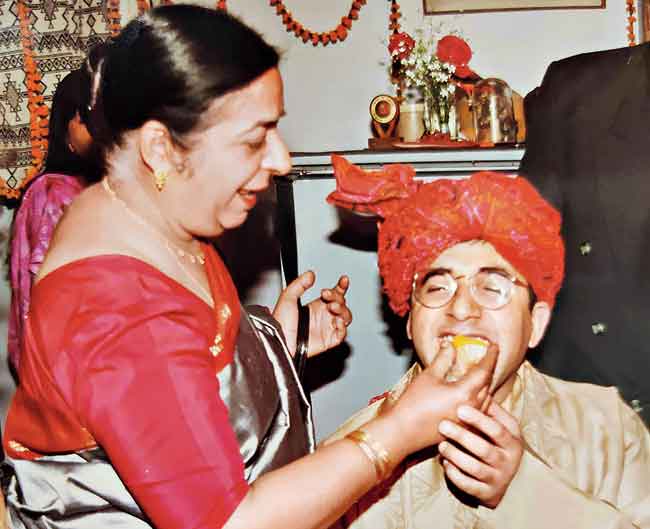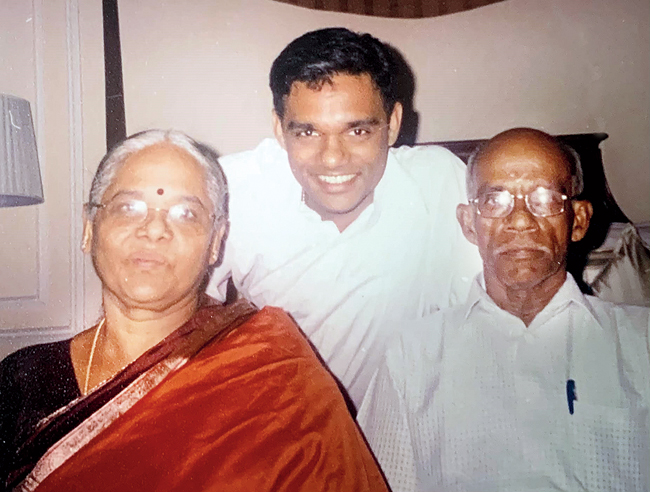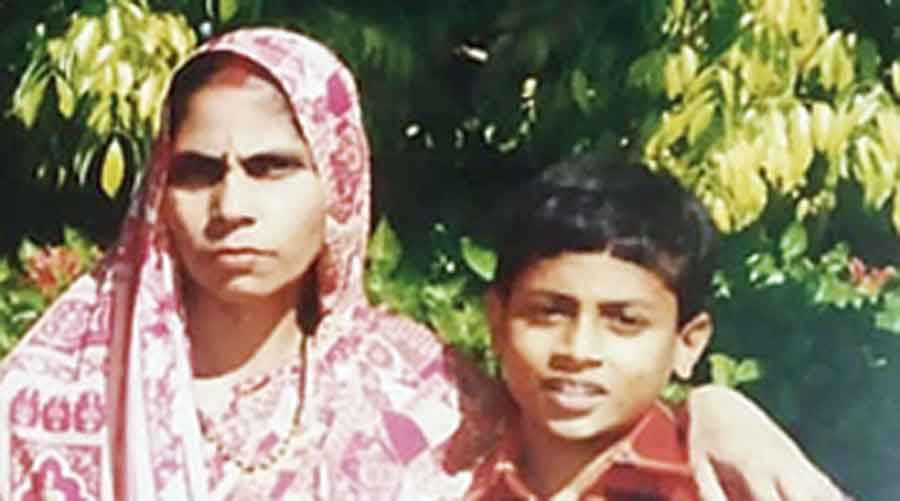Sharad Dewan, regional director — food production, The Park
Inspired from Doli Ki Roti — a fermented flatbread popular in northern India, the rustic Gud Ki Roti has always been a source of comfort and a saviour for chef Sharad Dewan on many occasions. The staple snack in Punjabi households brings with it innumerable stories from the chef’s travels and his growing-up days spent in Delhi’s cold winter.
“I must have been seven or eight when my mother had fed this to me for the first time,” says chef Dewan. He recalls a special trip where he sustained on its goodness. “On a month-and-a-half trip with my sister to South India in 1993, we saved a lot of money on food. Our last stop was Ooty but because we had earlier visited cities like Hyderabad and Bangalore, we weren’t carrying woollens so ended up buying jackets there and were running out of money. We used to eat two meals out and for the rest, these rotis and panjiri that my mother had packed for us. These rotis have a good shelf life and are nutritious,” he says.

Sharad Dewan with his mother Saroj Dewan on his wedding day in 1997
The meethi roti that almost tastes cookie-like, is made using chef’s schoolteacher mother’s original recipe. “Few years back, I had recreated this dish for a Baisakhi festival and sent her pictures. She was quite thrilled,” mentions the chef, while fondly remembering his mother, who is currently in Delhi.
Gud Ki Roti

Ingredients:
For the dough
⚫ Wheat flour: 500g
⚫ Ghee: 75g
⚫ Jaggery: 120g
⚫ Water: 80ml
⚫ Fennel seeds: 10g
For frying
⚫ Ghee/oil: 75g
Method:
⚫ Dissolve jaggery in warm water.
⚫ Sieve flour and add fennel seeds to it. Short the flour with ghee and add the jaggery water.
⚫ Knead semi-hard dough. Remember that it will be sticky, so knead slowly and add water.
⚫ Let it rest for 45 minutes and knead again. Make five equal balls for five rotis.
⚫ Roll the roti to about ½ inch thickness. If you find it difficult to roll, don’t do it with dry flour and instead, roll between two greased cellophane sheets.
⚫ Cook on low heat with ghee. Since, it gets absorbed fast, be cautious and don’t put too much in.
⚫ Cook one side completely before flipping, in order to avoid breakage.
⚫ Consume hot or cool, and store.

Prakash Chettiyar, executive chef, JW Marriott Kolkata
Once his mother’s staple, Thalicha Paruppu and Rasam now features on chef Prakash Chettiyar’s family meal menu that he cooks for his children. The flavours of the dish still linger on in his mind and palate. “My mother used to specifically make this for summer and monsoon because it has a lot of healing properties for the stomach. She used to make extra portions because I would enjoy having it so much,” says the Tamilian, born and bred in Mumbai.

Chef Prakash Chettiyar with his parents, Vellaiammal and Muthiah Chettiyar, at his workplace in Calcutta in 2006.
While the chef lost his mother 11 years back, the sight and smell of this dish still brings back all those memories from his childhood and his mother Vellaiammal’s affectionate touch. “It’s a coincidence that exactly around this time, she had passed away. And, now I cooked this dish for Mother’s Day too. There are few dishes that satisfies all your senses and you can’t really put it in words. This is one of those,” he says.
Thalicha Paruppu and Rasam

Ingredients:
For Thalicha Paruppu
⚫ Toor dal, 100g
⚫ Refined oil, 50ml
⚫ Ghee, 50ml
⚫ Mustard seeds, 5g
⚫ Shallots, 50g
⚫ Red chilli, 2
⚫ Curry leaves, 6
⚫ Asafoetida, 5
⚫ Turmeric powder, 1
⚫ Salt
For the rasam
⚫ Tamarind, soaked and pulp extracted, 75g
⚫ Tomato, boiled and pureed, 3
⚫ Garlic, peeled, 6
⚫ Jeera, 3g
⚫ Red chilli, 3
⚫ Peppercorn, 5g
⚫ Curry leaves, 6
⚫ Coriander leaves, 6
⚫ Mustard seeds, 3g
⚫ Asafoetida, a pinch
⚫ Refined oil, 50ml
Method:
For Thalicha Paruppu
⚫ Pressure-cook the dal with turmeric powder.
⚫ Heat 25g ghee and add mustard seeds, red chilli, curry leaves, shallots. Now add the boiled dal and give it a mix.
⚫ Add the remaining ghee and finish with asafoetida and salt.
For the rasam
⚫ Coarsely blend garlic, jeera, pepper, coriander and red chilli together.
⚫ Heat oil in a pan, add mustard seeds, crushed rasam masala and saute. Then add the tomato puree, salt, asafoetida, tamarind pulp, salt and let it simmer.
⚫When it starts frothing, switch off the flame and serve hot.

Chef Singh, executive chef, The Oberoi Grand
A Durgapur boy who has moved many cities due to his father’s job in the army, his mother, Manta Singh’s exceptional cooking skills has stayed with him. Her Kochupata Chingri to Bandakopi Bekti Bhapa are all etched in his mind, more so now since he lost his mother four years back.
“My mother used to make these dishes using basic and healthy ingredients like fresh turmeric and coconut, during my childhood. I was probably in class VI, when she started making a variety of paturis and not just with bekti but with katla, koi and bandakopi (cabbage) too. She would usually make these on my birthday or during Durga Puja,” says chef Singh.
Without any tweaks and twists, the recipe has been kept traditional to enhance its simplicity and bold flavours. “The dish would have been something else if I changed the recipe. My mother was the best chef in the family and would cook unique dishes like a raw banana chutney, made with its skin, which is usually discarded,” adds the chef, who loves cooking his mother’s favourite, biryani that some times has a hint of a regional touch.

Bandakopi Bekti Bhapa
Ingredients:
⚫ Bekti steak, 180g (90g each)
⚫ Cabbage, 2 leaves
⚫ Mustard seed, 10g
⚫ Grated coconut, 25g
⚫ Green chilli, 2
⚫ Mustard oil, 20ml
⚫ Salt, 5g
⚫ Gondhoraj lemon, 1
⚫ Lemon, 1
⚫ Poppy seed, 10g
⚫ Turmeric, 1pinch
⚫ Coconut milk, 20ml
⚫ Nigella seeds, 1pinch
Method:
⚫ Blanch the cabbage in salt water for three minutes.
⚫ Make a paste of mustard and poppy seeds, grated coconut and one green chilli.
⚫ Now, add salt, mustard oil, turmeric, lemon juice and coconut milk to the paste. Marinate the fish with this paste along with slit green chillies and nigella seeds.
⚫ Keep it aside for 30 minutes and then wrap the fish with cabbage.
⚫ Steam for 15 minutes and serve with steamed rice and ghee.

Vikas Singh,executive chef, Hyatt Regency Kolkata
Now a self-confessed fan of the humble green veggie, chef Singh gives the credit where it’s due — his mother Sumitra Devi’s cooking skills that made a 17-year-old start eating vegetables! “There’s a small story behind this dish. My mother had made this for somebody else and I thought of trying it because I hadn’t had a vegetarian dish such as this. Now, I can eat bhindi any time and in any form,” says the chef.

A 12-year-old Vikas Singh with his mother Sumitra Devi in Ambala
Being a single child and studying in five different cities across the country due to his father’s army job, cooking wasn’t something on his radar while growing up. In fact, even when it came to eating, chef Singh wasn’t particularly enthusiastic either. “I didn’t need to do a lot of things at home being a single child and when it came to eating, I wanted everything to be on one plate. Till today, my mother knows that she has to cook the Bharwa Bhindi with poori and doodh kheer or sewai, every time I go home to Gorakhpur,” he smiles.
Bharwa Bhindi

Ingredients:
⚫ Mustard oil, 10ml
⚫ Asafoetida, 1pinch
⚫ Bhindi (okra) , 300g
For stuffing:
⚫ Coriander powder, 1tbsp
⚫ Dry mango powder, ½ tbsp
⚫ Kashmiri red chilli powder, ½ tsp
⚫ Turmeric powder, ½ tsp
⚫ Jeera powder, ½ tsp
⚫ Saunf powder, ½ tsp
⚫ Black salt, ¼ tsp
⚫ Salt to taste
⚫ Garam masala powder, ½ tsp
⚫ Kasuri methi (dry fenugreek leaves), ½ tsp
⚫ Coriander for garnish, ½ tsp
Method:
⚫ Wash the bhindi under running water and cut it from the centre. Make a slit without completely tearing the pieces apart.
For the stuffing:
⚫Combine all the powders and salt, except asafoetida. Mix and stuff the masala in each bhindi. Keep aside.
For slow-cooking the Bharwa Bhindi:
⚫ Take a pan or tawa and heat oil in it. Keep the flame to low.
⚫ Add the hing (asafoetida) first, then immediately add the stuffed bhindi and gently stir.
⚫ Cook the stuffed bhindi on a low flame and don’t cover to avoid burning. Avoid adding water too.
⚫ Ensure that you check the bhindi in between and give a gentle stir every three to four minutes. Cook on a low flame.
⚫ After giving it a stir, make sure each stuffed bhindi is arranged separately for even cooking.
⚫ Take ½ tsp kasuri methi in your palms, crush and sprinkle on the bhindi along with garam masala.
⚫Garnish with coriander leaves.











